














Min 2005 by
Joyce Bruno & Robert WeaverPublisher
and EditorRobert Weaver
Columnists
Ronda Anson
Master Gardener
Abby Lapides
Sugar Creek Gardens
Steffie Littlefield
Edg-Clif Winery
Samantha Zale
Greenscape Gardens
Scott Woodbury
Cacalia Nativee Garden Design
Printing: Breese Publishing, Breese, IL
The Gateway Gardener® is published 7 times/year by Double Dig Communications, Inc. to promote enjoyable, successful gardening and livable landscapes in the St. Louis greater metropolitan area. The magazine is distributed free to the public at designated garden centers, nurseries, garden gift shops, lawn equipment rental, repair and sales establishments, and other locations supporting sound gardening, lawn and landscaping practices.
Please send letters-to-the-editor, questions, event announcements, editorial suggestions and contributions, photos, advertising inquiries and materials, and any other correspondence to:
The Gateway Gardener Magazine® PO Box 220853 St. Louis, MO 63122 Phone: (314) 968-3740
info@gatewaygardener.com www.gatewaygardener.com
any years ago, before The Gateway Gardener was a glimmer in my eyes, as they say, I was writing an article for a national gardening magazine about “shared gardens”—those cultivated spaces that cross property lines and are either tended by both property owners, or by one with the permission from the other. One of my subjects was an enthusiastic amateur daylily hybridizer who, having filled every available inch of gardening space in his own yard, and even filled the public median in front of his house, sought and received happy permission to spill his daylily creations onto the adjoining property. That was my introduction to the wide, wide world of the Hemerocallis genus beyond the ubiquitous orange “ditch lilies”, Hemerocallis fulva, that grew in my yard. Subsequently, as I’ve written about often and as recently as the last issue, when I became editor of this gardening magazine, and began receiving gift plants to trial in my garden, those gifts often came in the form of the latest offerings from the daylily


‘Mary’s Gold’ daylilies from the editor’s gardens.
world, for which I would gladly find a home. My favorite to this day is one bearing my wife’s name, ‘Mary’s Gold’. I think it’s the prettiest! (Racking up points, ka-ching ka-ching!)
All of which is a long-about way of introducing you to our guest contributor, Nikki Schmith, a longtime enthusiast and supporter of all things Hemerocallis, and whose home garden is one of 4 American Daylily Society certified display gardens in our area. To see pictures of her garden and learn more about it and other daylily display gardens— including the beautiful Jenkins Daylily Garden at Missouri Botanical Garden—turn to page 10.
Abby Lapides doesn’t mention any daylilies in her rundown
of favorite pink performers, though I’m sure there are some. But she offers up a variety of others to keep your garden Barbie-pink from midsummer into fall. Check them out beginning on page 4.
Scott Woodbury spins the color wheel from pink to (mostly) blue/purple in his study of native violets on page 8. The bane of many gardeners and turf perfectionists, our native violets are seen in a different light by Scott, who values them for many reasons, from their culinary uses and associated health benefits to their value as a filler in the garden and a host plant for the beautiful great spangled fritillary butterflies. You’ll find lots more in this issue, a good thing, since it must last you until we publish again in September. Until then, Happy Summer, Happy Father’s Day, and…


Pink adds a peppy and joyful feeling to the garden. From sweet ballerina to bright Barbie neon, pink can add a soft touch or a bold accent to the garden. Explore some excellent pink summer blooms.

With vivid hot pink ruffled flowers, ‘Puff Pink’ windflower, Anemone, rules the late summer garden. Long-stemmed perennial flowers bloom in masses over short foliage, perfect for cut flowers. Flowers open neon rose before slowly fading to antique pink giving a two-toned appearance. Foliage reaches about 12” tall with flowers doubling that to 24”. Use ‘Puff Pink’ towards the front of the garden where it will create a delightful short border that will pop with color when most plants are slowing down. With longs stems and dangling petals that dance in the wind, the Missouri native narrow-leaf coneflower, Echinacea angustifolia, creates a ballet-like performance in the garden. Soft pink petals surround a large orange center cone. Appearing in June and July, and sporadically for the rest of the summer, narrow-leaf coneflower creates wonderful displays in the garden and the vase.


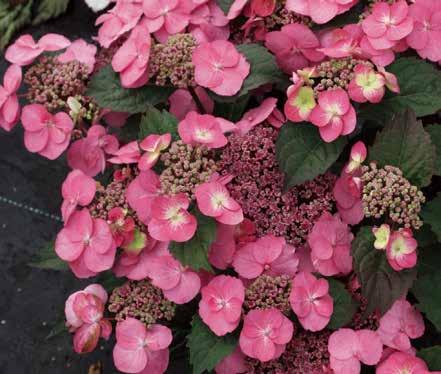



A tough beauty that is easy to grow in any soil, it thrives even in the hottest, driest, and most humid of summers. It prefers full sun to part shade, and birds adore its tasty seeds. ‘Sparkler Rose’ spider flower, Cleome, brings enormous, brilliant rose flowers on sturdy plants. Its bright flowers begin to appear in late spring and continue well into fall. Unlike its giant predecessors, ‘Sparkler Rose’ only grows 2-3’ tall, making it an ideal annual for gardens and containers. Don’t be surprised when you see butterflies and hummingbirds flocking to this jewel. A prolific bloomer, you can count on armloads of rosy blossoms. Use ‘Sparkler Rose’ in pots or in the garden for months of color. It’s fantastic alone in containers, and in the garden, it makes a showy specimen. It works well in cottage, cutting and pollinator gardens. Absolutely spectacular in large waves.
If you want brilliant late summer and fall color and the bonus of a major pollinator powerhouse, ‘Pavilion™ Pink’ bluebeard,
Abby Lapides is owner and a speaker at Sugar Creek Gardens Nursery. She has degrees from the University of Missouri, and is a member of the Landscape and Nursery Association of Greater St. Louis. You can reach her at (314) 965-3070.



Caryopteris, ticks all the boxes. Its Cinderella-pink flowers cover shrubs in late summer through fall when little else is in bloom. The airy puffball blossoms cover stems from top to bottom. The flowers are loved by bees and other pollinators – expect to be delighted as you watch them dance around this nectar-rich petite shrub. It only grows 15-18’ tall. Short-lived, usually lasting about 3-5 seasons.
Looking for something long-blooming, disease-resistant, and pink? ‘Cherry Bicolor’ Zinnia blooms nonstop from summer cont’d on next page



to frost with showy raspberry-pink star-shaped flowers. The flowers on this color-changing wonder open white with a deep cherry streak. As flowers age the white slowly turns a vibrant pink adding a delightful multi-colored effect. This tough annual thrives in heat and humidity and is loved by pollinators but disliked by deer. Great for borders or containers in sunny spots.
‘Incrediball® Blush’ smooth hydrangea, Hydrangea arborescens, provides large pink flowers and sturdy stems. In the fall, the blossoms transform to deep chartreuse, creating another dramatic
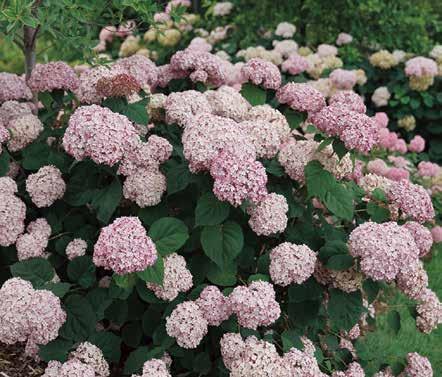
sight. The long-lasting dried flower balls last well into late winter on the shrub or for months more in home arrangements. Its strong stems hold the massive flowers up, even in heavy rain. A hybrid of the Missouri native shrub, ‘Incrediball Blush’ is as tough as it is beautiful. Blooming on new growth, it’s guaranteed to bloom every year, even after a harsh winter.
Use some of these pink beauties to create a friendly, welcoming garden.



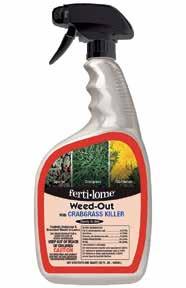

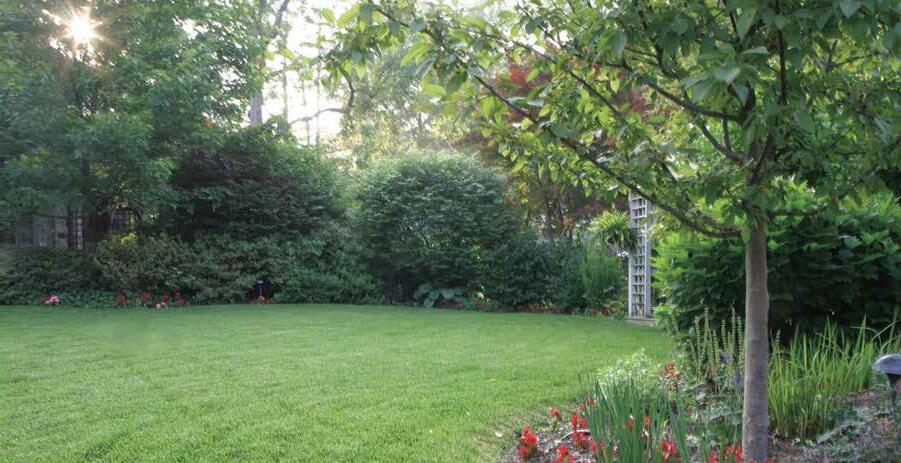







Euell Gibbons knew that half a cup of chopped violet leaves has the Vitamin C content of five oranges. It was a favorite wild edible of his, which fed his desperate family in lean
Everything good, everything the months of June and August. happens between
– JENNY HAN

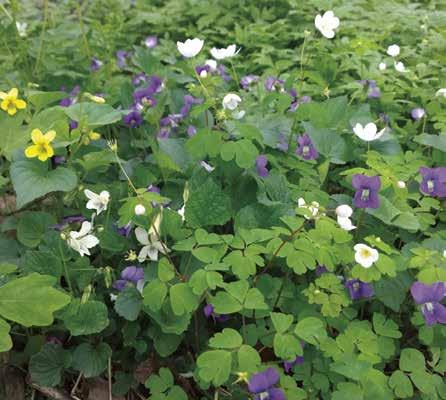
times, and later appealed to his back-to-nature followers, who were hungry for wild-foraged ingredients and recipes found in his popular books Stalking the Wild Asparagus (1962), and Stalking the Healthful Herbs (1970).
I enjoy walking in Gibbons’ footsteps, gathering tender violet leaves and flowers to enjoy with meals, especially salads and desserts. There is always a decent supply of violets in my garden because I choose to leave them be—they are my little garden helpers. In the wild garden, violets are a foundation for
stability. They are ephemeral placeholders that pop up (from seed) in the gaps between larger, longer-lived plants that I install. Here, they establish quickly, having been brought in and moved around by ants, not me. Violet seeds have little fat- and protein-rich appendages called elaiosomes that ants love to eat. In the process of moving the seeds around to eat the elaiosomes, the ants help disperse them. Violets out-compete weeds that would otherwise show up in bare spots, especially in the shade. That’s how they can stabilize the wild garden, reducing weeds, and therefore maintenance, once plantings are established.
However, the stars must align:
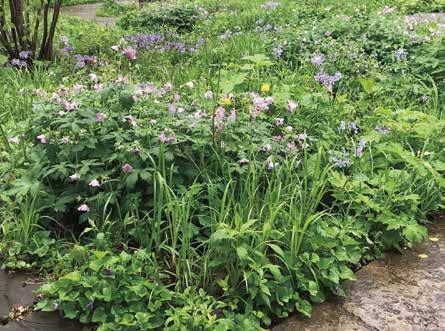
A balanced ratio of installed plants to violets is critical. If plants are initially installed at 16 to 20 inches apart, then you will end up with a desirable amount of violets. If plants are spaced 24 to 36 inches apart, violets are allowed too much real estate to march into and possess. When the ratio is right, your intended plants eventually fill out and squeeze excess violets out by the end of the establishment period (2 to 3 years). If the spacing is right, violets should diminish over time and settle into a nice equilibrium with all the other plants.
Another important thing is to keep the garden bed mulched during establishment to reduce weeds and avoid soil disturbance. Every time a weed is pulled, or rainwater washes mulch away, soil is exposed, encouraging more weeds. So when soil is exposed, cover it with mulch as soon as possible. Leaf mulch is preferable to wood mulch. Take care not to suffocate plants with mulch. Lastly, choose the right plants for the right place. Violets tend to grow in some shade, so the obvious plant palette would be for open woodland (shade) or savanna (part shade) species. Longlived species like Joe pye, sensitive fern, Jacob’s ladder, wild sweet William, wild geranium, columbine, American beak grass, Indian plantain, and round leaf groundsel are great choices.

Scott Woodbury was the horticulturist at Shaw Nature Reserve for 30 years and stepped down from that position in June 2022. He continues to work on contract for Shaw Nature Reserve to carry out native landscaping education and has launched his own business called Cacalia: Native Garden Design and Wilding. Find suppliers of aquatic and other native plants and services, native garden plans, educational programs, and much more at grownative.org.
You could even add violets if none already exist. I’ve occasionally seen yellow violet (Viola pennsylvanica) and striped cream violet ( V. striata) for sale at native plant nurseries. Most yards already have butterfly (common blue) violet (V. sororia). This is the one that gardeners weed out when there are too many.
I used to be That Gardener—I weeded violets regularly, perhaps because that’s what I was taught. Now I see things differently. I love violets, I enjoy their blooms every spring, and I look for the great spangled fritillary butterflies whose caterpillars depend on the foliage for food. And like Euell Gibbons, I eat them every chance I get, not just for the free vitamin C, but for the enjoyment they bring. The native garden is full of so many things. Every native plant is an adventure!

9814 Pleasant Hill Rd Jefferson City MO 65109
www.mowildflowers.net mowldflrs@socket.net 573-496-3492, fax: 573-496-3003
We’ll be in the St. Louis area in the fall. Watch for our ads here in August & September.
Shopping at our Brazito (Jeffeson City) store: Visit our home location any of the times listed below. You can also place an order and pick it up at the nursery.
Hours:
Weekdays: Year-Round: 9 AM - 5 PM
Weekends: March 16 - July 7 & August 31 - October 13
Saturdays: 9 AM - 5 PM, Sundays: Noon - 5 PM
We can ship your order! We ship plants on Mondays, Tuesdays and Wednesdays all year. UPS usually delivers the next day to Missouri and the surrounding states. Shipping charges apply.
text and photos by Nikki Schmith
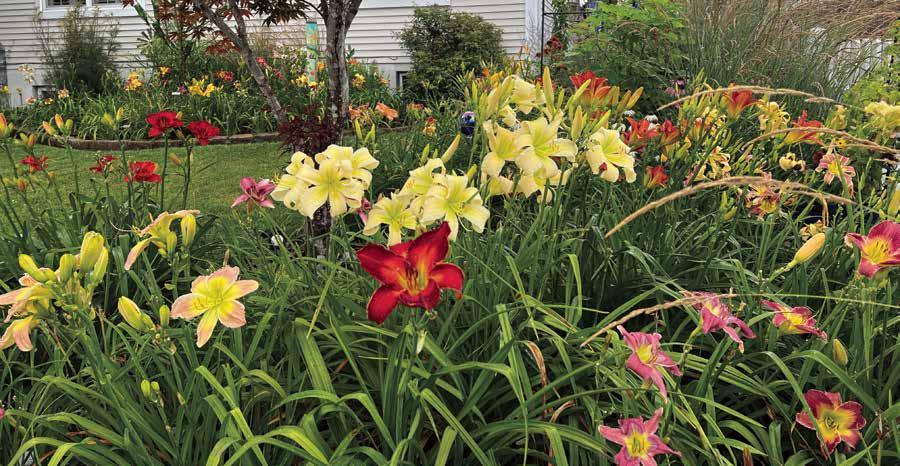
Gardeners who call themselves “daylily fans” (pun intended) are enchanted by the continuous variety and breakthroughs in color, form, height, and size. After all, there are now over 100,000 registered daylily varieties, which means there is something for everyone! Daylilies come in nearwhite to near-black and everything in between but true-blue. Modern hybridization is bringing 1” and 13” daylilies into sight. Daylily gardening holds a significant place in the hearts of many enthusiasts for several reasons. Firstly, daylilies are incredibly versatile and resilient plants, making them ideal for both novice and experienced gardeners alike. They thrive in various climates and soil conditions, requiring minimal maintenance while offering maximal visual impact. Their vibrant blooms, which really last only a day but are replaced by new ones in quick succession, create an ever-changing tapestry of colors and textures throughout the growing season. Visiting daylily-focused gardens is the best way to experience the consistency and beauty the daylily brings to the modern landscape.
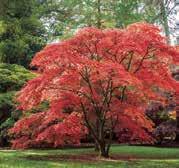


Did you know that you have an open invitation to visit 200+ private daylily gardens across the country?
One of the many benefits of American Daylily Society (ADS) membership (www.daylilies.org) is to have their gardens accredited by the official Display Garden program. There

are over 250 official display gardens certified by the ADS throughout the United States, Canada and Europe where visitors can view a variety of daylilies in a garden setting. These gardens are established to provide public access to the very best daylily cultivars and educate visitors about modern daylilies in landscapes. There are four official Daylily Display gardens open for your enjoyment this summer within two hours of downtown St Louis – including the incredible Jenkins Daylily Collection at the Missouri Botanical Gardens.
To be awarded ADS display garden status, members apply and their gardens must be visited, approved, and recommended by a society delegate. It is recommended the garden setting have a minimum of 100 different registered daylily cultivars, clearly marked, generally weed-free, accessible, and open to the public at least once during peak bloom season.
In the nearby Village of Worden, Illinois, I am the lucky steward of one of these national daylily display gardens. We moved here from the Detroit suburbs in 2011 and I brought most of my Michigan garden with me to a blank slate – every gardener’s dream. My collection contains 320 hybrid daylilies this year, tucked in among hundreds of other annuals and perennials. I’m a best-in-show daylily exhibitionist and a senior exhibition judge, and I’m just crazy about sharing my daylily delirium with everyone. Although the number of daylilies I grow is not spectacular by collector’s standards (some display gardens boast 1500+ cultivars,) the quality of the collection is top-notch and ever-changing. I collect daylilies that spark conversation with wild colors, challenging forms, elusive fragrance, striking presence, or other characteristics that earn their real estate in this
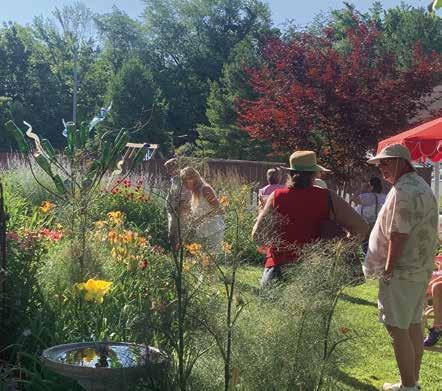
small garden. A few uniquely-named daylilies anticipated this summer are ‘SUMMERTIME PUNCH’, ‘ORANGE YOU BOB’, ‘GAGA’, ‘INCESSANT’, ‘MIDNIGHT IN THE GARDEN’, ‘WARMTH OF OTHER SUNS’ and ‘GIRL ON FIRE.’ Peak bloom season is June 25-July 15 for this area and I expect several groups of visitors during that time. There are always chilled
cont’d. on next page

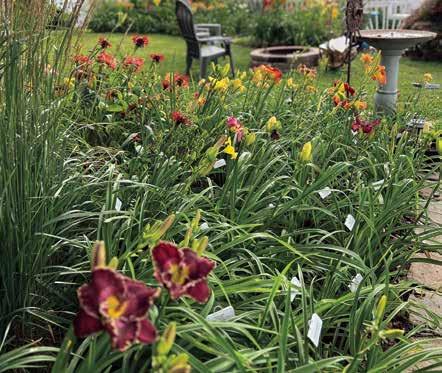
Over 300 hybrid daylilies plus hundreds of other annuals and perennials are on display at Nikki Schmith’s ADS Display Garden.
washrags, cold drinks, peppermints and smiles here for garden tours, but it’s important to call ahead before your visit to any display garden. (Contact information for all display gardens is listed on the ADS website https://daylilies.org/daylilies/displaygardens/ See pg. 15 for more about the other 3 gardens nearby.) There are many award-winning daylilies planted here, some dating back to 1924, and some as new as 2024. I’m proud to display 100 years of daylily innovation in my little green space. Why? Daylilies are a lot like fashion - if you lined up dresses from the 1920s, 30s, 40s and so on to the 2020s, a keen eye could identify what period each dress represents. Like the dresses, daylilies over time show trends that have come and gone and come back again. Many of those trends can be observed in carefully organized Display Gardens found in 80% of the lowerUS!
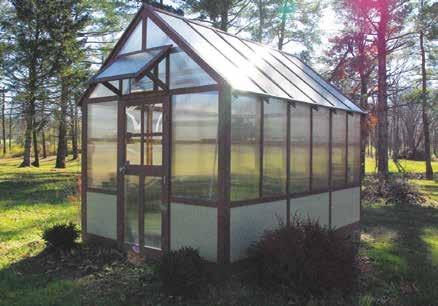

What do visitors do when they visit a display garden? We stroll and chat and hopefully exchange some good information about the daylily community. Most folks stay about an hour and then head to any one of several great diners and stops along historic Route 66. The purpose of the ADS Display Garden Program is to encourage togetherness in our home gardens, among the daylilies. I try to have educational handouts, previous Daylily Journal issues, and my favorite garden tools out for discussion and sharing, too. There are also other daylily-centric gardens near me that are not certified display gardens, but I always recommend visitors stop by there, too. Some display gardens offer sales of daylilies and others do not. I do not sell out of the garden during visits, and only have one sale a year, through Facebook. For the last eight years it has been a sellout within hours of posting the list of available plants. The next one is slated for August, after most of the plants have finished blooming and new arrivals are patiently waiting to take their place.
Display gardening styles are just as varied as the forms of the daylily itself. Some display gardens are farm-style or formal, others are chaotic, chronological, or careful. Sharing tips, exchanging varieties, and attending local garden club meetings or daylily festivals are common practices that bring people together, fostering friendships and camaraderie.
Overall, daylily gardening offers not only visual beauty but also ecological benefits and social connections, making it a rewarding and important pursuit for gardeners of all levels. Moreover, visiting daylily gardens in person fosters a sense of community among enthusiasts.
Wherever you are, the ADS website provides an interactive map of all the official daylily Display Gardens, which can be used to plan your next daylily adventure. I hope to see you in the garden sometime soon.

Nikki Schmith is a past president of the American Hemerocallis Society and continues to serve the society on various committees. In 2022, she was awarded the Helen Field Fisher Gold Medal for a lifetime of exemplary service. Her garden contains a rotating collection of around 350 daylily cultivars, hundreds of other perennials and various unique container plantings. She is a writer, photographer, collector, ambassador and nine-time Best in Show winner of accredited daylily exhibitions. You can find more of her at www.agirlandhergarden.com, Facebook and Instagram.

Agarden can be designated by specific characteristics related to structure, plant selection, and environment. Consider the many areas of the Missouri Botanical Garden and the ways in which a particular space incorporates certain plant selections. For instance, English Woodland Garden is structured to embrace the layers of a wooded environment. The Sensory Garden is designed to encourage engagement via a plant selection which deepens our connection through all senses. The experience of exploring sensory plants draws us in so that we can be fully immersed in the present moment. If you want the beauty and immersion of a sensory garden, but have limited time, space, or funds, a Sensory Porch Pot might be just what you need! Sensory Porch Pots take the ideas behind a sensory garden—fragrant, textured plants and flowers that engage all of the senses—into smaller scale. When designing a Sensory Porch Pot, go beyond the typical design of “thriller, filler, spiller”, and consider scent, texture, shape, color and even taste when choosing your plants.

sensory pot. One of our favorites is lemon-scented, with lemonade thyme, lemon basil, and lemon verbena.
The most carefully crafted Sensory Porch Pot is nothing more than background furnishing unless you engage with it regularly. Place your porch pot near a door or beside your patio furniture, giving you and any summer visitors an ample opportunity to pet the plants. A pot of scented geranium placed at hand height next to the front door will fill your mornings with fragrance as you run your fingers through it on your way out the door. Every little engagement with the plants (and other natural treasures) in our lives gives us an opportunity to return to the present moment, and a chance to remember how amazing this world really is.
Herbs make an excellent addition to Sensory Porch Pots. Include Corsican mint (Mentha requienii), or Tricolor sage (Salvia officinalis “Tricolor”) for delightful texture that leaves a lasting, pleasant scent on your fingers. Scented geraniums (Pelargonium) are a fantastic addition as well; their flowers are smaller and less showy than their better-known cousins, but their foliage comes in a vast array of fragrances. Local nurseries may have available lemon, rose, orange, and even nutmeg-scented geranium. If you want your sensory pot to double as a tea garden, include lemon verbena, chamomile, or even stevia. Taste is, after all, a sense that is every bit as important as the others!
A Sensory Porch Pot would be incomplete without plants that bring texture into the mix. Dusty miller (Jacobaea maritima) is a favorite for its soft leaves, as is Plectranthus ‘Velvet Elvis’, and any variety of celosia. Consider also the idea of a themed
The Therapeutic Horticulture team of the Missouri Botanical Garden is comprised of a dedicated group of individuals from varying backgrounds. The common thread is a commitment to the effort to help participants deepen their connection with nature to improve well-being. We enjoy the opportunity to provide inspiration and ideas through these articles. Please feel free to connect by emailing MBGTH@mobot.org.

The Royal Entomological Society estimates that there are over a billion individual insects for each person on earth. Choosing just one kind of insect as the most important is impossible of course, because we need them all. But if we had to choose, most people would probably choose bees or pollinators in general; however, I choose ants.
Ants just don’t get the respect they deserve, possibly because we never see the incredible things they do for us. They are beneficial predators, eating immature grubs, grasshopper eggs, and many small pests, not to mention being the number one predator of termites.
Plants often encourage ants to draw near in order to benefit from this protection. For example, many plants have extrafloral nectaries independent of nectar producing flowers. These nectaries are often seen as small bumps at the base of leaves, such as with plants in the Prunus family. It is thought that by providing an extra source of nectar, the plants gain from the ants against other destructive insects. Peonies are another common garden flower that use this mutually beneficial arrangement to their advantage.
Ants are also a major food source for other creatures, such as bears, pileated woodpeckers and many other species of

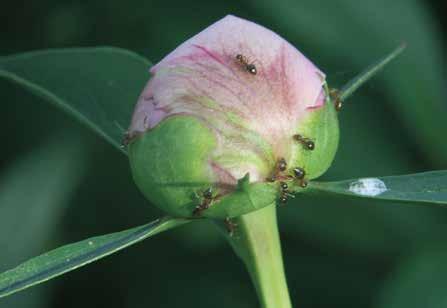
birds. Additionally, they are members of nature’s cleanup crew, scavenging dead insects and dead plant material. But most of all, they aerate the soil. We all value earthworms for aerating the soil, but ants aerate the soil just as much as earthworms do and possibly more. Both ants and earthworms create air spaces in the soil so that plant roots can thrive, which is why I choose ants over bees, because without plants there would be no
Okay, yes, they are annoying when they invade our kitchens. At the St. Louis Garden Hotline, how to get rid of ants is a common question, and if the ants are inside the house, the answer is simple: baits. Usually that response is followed by the words: “I tried that and it doesn’t work.” Actually baits do work, but success depends on understanding
Ant colonies send out scouts looking for food. That process includes leaving a scent trail to guide other worker ants out to collect the food and bring it back colony. All food is consumed by the who regurgitate it the entire colony. Sort of like birds but in reverse. Instead of adult birds regurgitating food for baby birds, ant babies regurgitate food for the adults. This
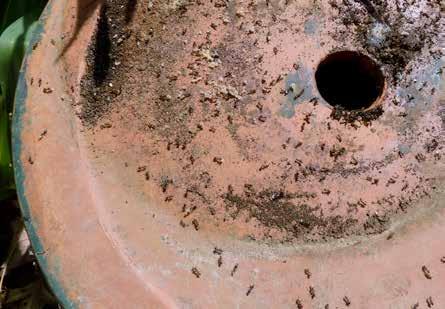

Ants are members of nature’s clean up crew, scavenging dead insects, bringing them back to their nests, and in doing so enriching and aerating the soil.
is because the constricted waistline of adult ants prevents them from swallowing solid food.
So the key to controlling ants with traps is getting the bait to the larvae. You do this by allowing the ants to come and go unhindered. Usually it takes a few days for the poison to kill the colony. (The “poison” is borax--like borax soap--mixed in sugar water. So, while it’s poisonous to the ants, it’s safe around children and pets, unlike more toxic insecticides. Still, it’s best to place the baits where they can’t be accessed by your two-and four-legged friends.) If you kill the ants while they are in your house, new ants will continue to appear. By killing them inside the house, you are preventing the workers from taking the bait back to the colony. To stop the ants, all you need to do is put out the baits, preferably at the point where the ants enter the house, and then ignore them. Let them run around for a few days and they will soon be gone.
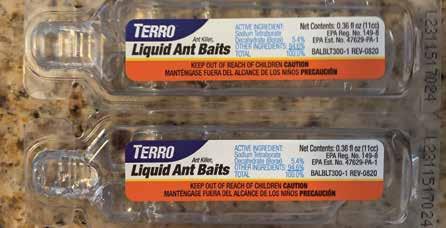
the outside air, turn the flower pot upright, open the mail box, cut open the lettuce. Within a few hours, they will be gone. Or if the flower pot or container has plants in it, flood it with water. Ants can be pests in certain circumstances, but really we cannot get by without them.
For more information about ants in Missouri, do an Internet search for MU Guide g7392 or for carpenter ants, search for MU Guide g7423.
Ronda Anson is certified as both an Illinois Master Gardener and St. Louis Master Gardener. She was a longtime Horticulture Answer Service and Plant Doctor volunteer at Missouri Botanical Garden where she developed an expertise in the world of insects. She coordinates the gardening answer service for MU Extension - St. Louis County, which you can reach at (314) 400-7657 or email: STLgardenhotline@gmail.com.

Ant baits such as these are an effective means of eliminating colonies of ants that are coming into your home, and are safe to use around children and pets.
At the St. Louis Garden Hotline we sometimes are asked how to control ants outside. The answer to that is also simple: You don’t. Rarely are ants doing any harm outside. People just don’t like them, but outside is where ants belong. It is their domain. Without them, we would have compacted soil, more pests, and hungrier birds.
Unfortunately, there is sometimes a problem when the soil is waterlogged. As the rain comes down, the ants come up. With their homes flooded out, they look for drier accommodations; such as, flower pots, mail boxes, even heads of lettuce. They will move their entire colony: adults, larvae, eggs. To get rid of them, you do not need a pesticide. Simply expose the colony to
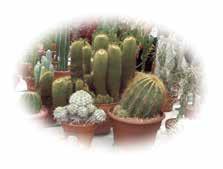
July 20-21, 2024
• Browse and buy amazing plants and pots from multiple vendors. Beginner plants to rare specimens.
• Big show features awesome succulents from around the world, too! Saturday 9-5, Sunday 9-4

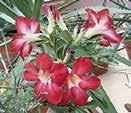
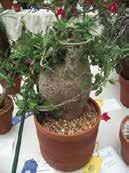

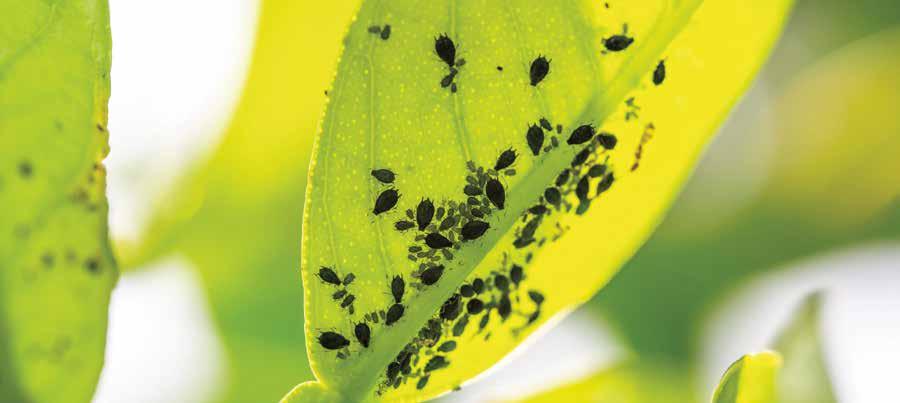
Outdoors, summer is the time for plants to mature and fruits to grow. Sometimes we get so preoccupied carrying for our outdoor gardens, we don’t observe what might be going on indoors with our on tropical houseplants. It doesn’t take long at all for critters to take advantage of our oversight. A few houseplant pests to keep your eyes peeled for are aphids, whiteflies, scale, thrips, fungus gnats, mealybugs and spider mites. While these pests can affect any plant seemingly at any time, there are a few things to look out for and ways to handle the situation.

Here we’re talking about 7 types of pests in particular, but there are tons of insect types with many variations. Aphids come in a variety of colors, but red, yellow, green and brown/ black are commonly seen. They are small and generally appear quickly, seemingly overnight in large conglomerates. Whiteflies are even smaller than aphids and almost look like white bits of dirt. They also tend to appear in large groups which make it look like the leaf is really dirty just glancing at it. Scale generally looks like a little domed shell on leaves and stems. Another sign that pests like these are attacking your plants is when you see a sticky residue, called honeydew, which is pest excrement. Typically, this stickiness will be seen below where these bugs are hanging out. Be sure to check under

leaves and in nooks & crannies.
Thrips are very small cigar shaped insects that favor houseplants with thin broad leaves such as monstera, alocasia, and calathea. They tend to cause distorted fruits/young leaves and areas on leaves that look thinned and bronzed.
Fungus gnats are very common and look like what they sound like. They tend to hang out in the soil, particularly if the soil stays too moist, which can easily happen indoors. A product called Mosquito Bits is particularly helpful for fungus gnat control where a few of granules can be added to the soil.
Leaf curl is another sign that a pest is feeding on your plant, particularly new leaves that are supple and full of juices. This is a common finding with aphids, whiteflies and thrips. Mealybugs are white and look like fuzzy pill bugs (also known as rollie pollies) and can be quite small when they’re young. They tend to be found in crevices becoming large groups over time. All the while their honeydew gets all over the place.
Spider mites are very small and are sometimes hard to spot, but they tend to cause almost a mottled look on the leaves and
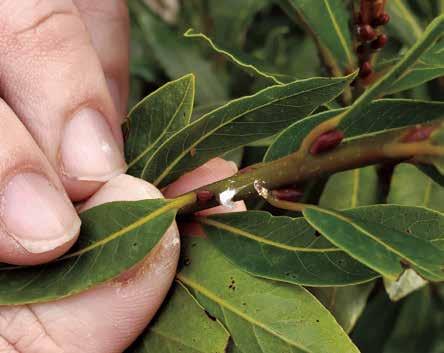
webbing resembling a spider web.
If you are in a pinch, diluted 70% isopropyl alcohol can be used to wipe down the plant or used as a spray when you spot these pests. You can also hose down the plant outside to help knock off some of these pests. Scale requires a little more work, because they’re armored and you have to get under their shell to be effective.
There are several products on the market for these sorts of pest, but one thing to look for in particular is a ready-to-use spray that contains neem oil. Ready-to-use for ease of use, with no mixing or measuring necessary, and neem oil because being oil based it suffocates pests, particularly immature insects. The main thing to remember is that when using oil-based products, take care to not use during the hottest part of the day as it can burn the foliage, particularly delicate foliage. Another product to have in your arsenal is a systemic granular that is applied to the soil every several weeks depending on your product’s instructions. Another product to have at the ready is either a ready-to-use or concentrated version of insecticidal soaps or horticultural oils that contain pyrethrins, which is particularly useful for thrips, aphids and whiteflies.
In all cases, be sure to check the label to ensure it is approved and safe to use indoors.
While finding critters on your plants is always disconcerting, proactively checking your plants, routine maintenance and having the proper tools on hand can set you up for more positive outcomes. Don’t hesitate to swing by your garden center and to chat with those folks about any issues you may see on your plants this summer, indoors or out!

After reading about and seeing photos of Nikki Schmith’s beautiful American Daylily Society accredited display garden beginning on page 12, you may wish to see more. In fact, there are 3 other such accredited gardens within a couple hours drive of St. Louis. Except for the Missouri Botanical Garden’s beautiful Jenkins Daylily Garden, which you can visit anytime during open hours with membership or entrance fee, the other two gardens require advance reservations. Please respect these private owners’ requests.

The Jenkins Daylily Garden at Missouri Botanical Garden.
4344 Shaw Blvd.
St. Louis, MO 63110
The Garden displays more than 1,800 specimens, with over 1,600 in the Jenkins Daylily Garden. Of those hundreds of plants, there are over a dozen species represented and over 1,600 different cultivars.
21300 Marks Crossing Circle, Warrenton, MO 63383
Contact: Laura & Tom Hood
Phone: (636) 887-0119
Email: laura@naturesmelodynursery.com
Preferred Contact Method: Phone Call, Email Website: https://www.naturesmelodynursery.com/ Appointment Necessary. Call for the best time to see the gardens in full bloom.
This garden is in a rural setting with the display beds beside a small lake. There are many winding paths between the curved beds. There is a wide variety of perennials as companion plants to try to have something in bloom all season long. There is a nice display of daylilies in all forms and sizes. The collection has both newer and older varieties. Laura is also a hybridizer and grows her seedlings on the lot adjacent to where the display beds are laid out.
1670 Welsh Lane, Fulton, MO, USA
Contact: Leemer Cernohlavek
Phone: 573-642-8706
Email: leemer@socket.net
Preferred Contact Method: Phone Call, Email Website: http://redbirdhilldaylilies.com
Appointment Necessary
Mostly Flat Terrain, Features Other Plant Collections, Private Garden
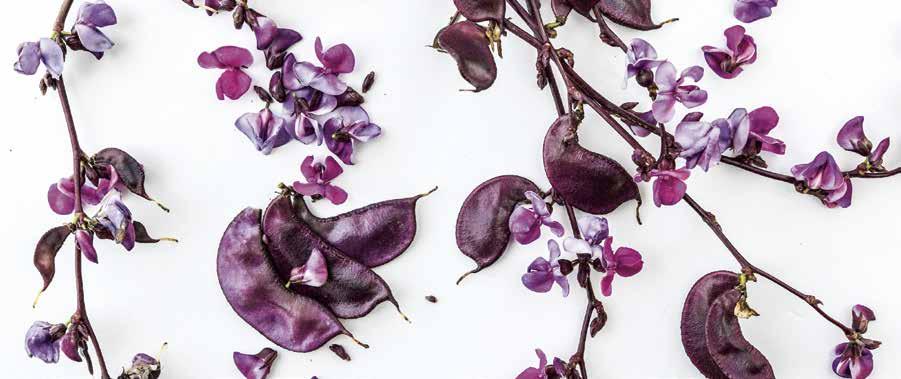
eans, beans the more you plant the more you reap! This is an easy crop for the beginning gardener and they can be planted late because they are fast! I love to plant all kinds of beans. Everyone loves green beans, yellow beans, even
Don’t have a convenient pickup spot near you, or the rack is empty when you get there? Just complete this form and mail it with $24 for postage and handling to the address below. You will receive 7 issues (a one-year subscription) beginning with the next issue.
To:
Address:
City, State & Zip:
Phone (opt.):
Email (opt.):
Please make your check payable to The Gateway Gardener and mail it with this form to: The Gateway Gardener • PO Box 220853
St. Louis, MO 63122
purple beans, bush beans, climbing beans, yard long beans, Edamame(Soybeans) and pretty Hyacinth Beans or Scarlet Runner beans. I do it all!
The most common beans to grow are green and can be climbing or bush depending on your style of garden. I devote one of my raised beds to bush beans. There I plant a French Fillet type of green bean which will be fast to develop a crop, tender to eat and enjoyed by the whole family. Now because I love to add color to my vegetable assortment, I also plant a packet of golden pod beans like Goldrush or Golden Wax and purple podded, like Purple Queen or Purple Prince.
I do love some climbing or Runner beans for the drama of their growth, flowers and fascinating pods. My reliable-to-reseed variety known as yard-long bean has delightful lavender blue flowers and, long dangling pods. It just pops up in my garden in the late spring/early summer and doesn’t mind my moving the seedlings around to fill in my tall fence. I love these beans so much I also have devoted a whole raised bed to their abundance and installed a wire fence panel through the middle of the bed to give them plenty of room. They love to reach the 6’ height of the fence and provide a nice mid-summer crop of fresh beans. If kept harvested they really produce all summer. If you have an arbor

Steffie Littlefield is a St Louis area horticulturist and garden designer. She has degrees from St. Louis Community College at Meramec and Southeast Missouri State and is a member of Gateway Professional Horticultural Association, Missouri Botanical Garden Members Board and past president of the Horticulture Co-op of Metropolitan St. Louis. She is part-owner of Edg-Clif Winery, Potosi, MO. www.Edg-Clif. com.
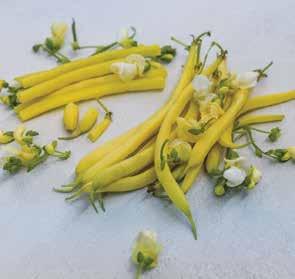

in need of something vigorous and showy, plant Hyacinth bean seeds with dark leaves, gorgeous lavender flowers all summer, and fantastic shiny purple pods that are edible. In fact, Thomas Jefferson grew this and many other unusual beans in his garden to delight his guests with exotic foods. Another showy variety is the Scalet Runner Bean, a true heirloom as well with eye-catching red flowers, attracting hummingbirds and butterflies to the garden, the larger rustic pods can be harvested young and eaten like any green bean, or allowed to mature and develop pink beans that can be shelled and eaten like lima beans or in chilis and baked dishes. This topic now brings us around to the beans we grow and eat outside the pods like Lima, Soy, Navy and Kidney beans. Many of these can be easily grown in the garden in bush or climbing varieties. I focus on beans that I want to eat fresh and not dried since the dried ones are easily found. I love to harvest fresh Edamame from the garden. I just give them a quick rinse, steam with sea salt and eat that night. They also grow as small bushes, flower quickly and produce prolific amounts of fresh tender pods of soybeans.
The key to success with beans and legumes in general is treating the seed with a Legume Inoculant for organic use. This natural bacteria will colonize on the roots and make the free nitrogen in the air available to the plant roots to promote faster growth and higher yield. I use this for both peas and all beans. Other growing tips include waiting to sow until soil temperatures are warmed in May. Also, mid-season when the insect population seems to ruin the bush bean plants, cut them back, water and fertilize, which will stimulate late season growth and a second flush of fresh flowers and beans to harvest. Another tidbit that contributes to the


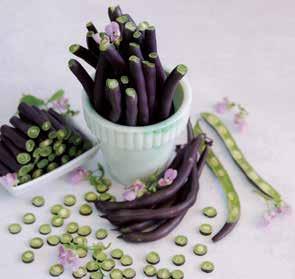
health of the entire garden; don’t dig all the roots out, just cut the tops, then rotate the bean beds as much as you can from year to year so that the next years vegetables in that bed can benefit from all that nitrogen concentrated in the bed from the roots composted over winter.
Photos courtesy Baker Heirloom Seed Co. / rareseeds. com


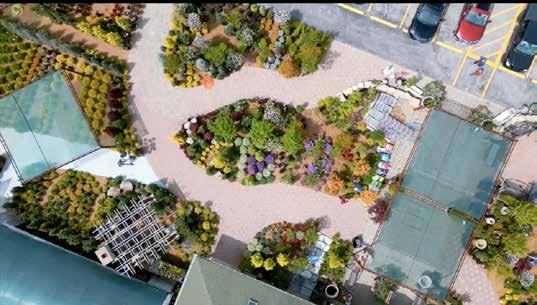
Last month we featured many garden tours that were coming up this summer. Because of the early deadlines, plans were incomplete for some tours and events. But a month later, we’ve been able to gather information for a few more late summer/early fall events we’d like to highlight here. Mark your calendars!

Edg-Clif Vineyard, Winery and Brewery, and other Washington County locations
Explore Farm Country and Celebrate the growing season in Historic Washington County on Saturday, August 24th by attending the 15thAnnual Home Grown Farm Tour. The event kicks off with “Farm & Charm”, a morning of local shopping going from 8am12pm. The Washington County Farmer’s Market as well as the businesses in downtown Potosi, MO will be participating. The ‘Farm & Charm” morning event, will also include a small vendors setup, sponsored by Naturally Meramec with information booths and local vendors from the region along-side market delights of produce, homemade jams, breads and honey.
During the day enjoy a self-guided tour of the areas farm producers and spectacular sites. Visiting the YMCA Troutlodge Ranch, Old Man River Retreat, Rocking Goat Farm, Altus Hook and Horn Ranch, Tri-Creek Cattle Co, Maupin Family Farm, Big River Alpacas, Sunset @ the Silos and Valley/Caledonia FFA Farm. We invite all our Farm Tour Visitors and Friends to join us for the Silent Auction and Benefit Concert at Edg-Clif Winery on Saturday Aug 24th at 6:30pm. The Auction has a long list of local products, art and experiences. The Benefit Concert will feature local entertainers playing all together for an epic annual Concert called The Sounds of WashCo. The silent Auction and Benefit
Concert are open to everyone and do not require a ticket.
Pick up your map for the free self-guided Home Grown Farm Tour at the Farm & Charm Marketplace in the Town Square.
Upgrade your Home Grown Farm Tour experience and support local farming with the Field Dinner with Food Stops Ticket. Included in this is a breakfast option at the Farm & Charm Morning event, two light snack options at two different Food Stop venues during the afternoon, as well as the Field Dinner. These Food Stops feature locally sourced food to bring you the best and freshest experience. Followed by the main event at Edg-Clif Vineyard, Winery and Brewery, the Farm to Table Field Dinner, Silent Auction and Live Music.
The upgraded experience is $50/person and can be purchased on the website www.homegrownfarmtour.com, or you may email homegrownfarmtour@gmail.com to make your reservations. The proceeds from the Field Dinner and Auction are used to support agricultural scholarships and farm business grants for Washington County residents.
Thank you to the Washington County Chamber of Commerce for your continued support of this event.
Timberwinds Nursery 54 Clarkson Road Ellisville, MO 63011 September 20th-22nd
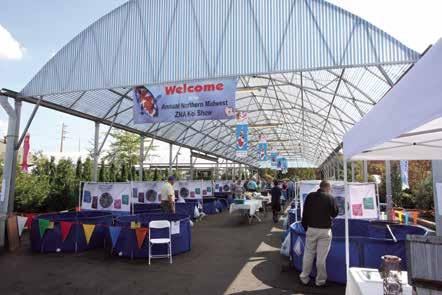
The Gateway Koi and Pond Club of St. Louis will host the 22nd Annual Northern Midwest ZNA Koi Show & Pond Expo on September 20-22, 2024. The event will be held at Timberwinds Nursery in Ellisville, MO and is open to the public with free admission. Hours are Friday 3-5pm, Saturday 9am-5pm and Sunday 10am-2pm. There will be raffles, attendance prizes, koi judging and speakers on various topics of ponding and gardening Saturday, along with the judges’ talk and tour of the winners’ tanks on Sunday. Show koi will be removed from tanks for transport home on Sunday at noon. Koi, goldfish and pond & garden-related vendors will be open all three days. Timberwinds Nursery carries a wide variety of high-quality plants, shrubs and trees along with decorative garden and gift items. Show schedule is available on www.gatewaykoiandpondclub.org and www. nmzna.net. Come enjoy the beautiful living jewels of Japan! Fun for the whole family! Outdoor event-rain or shine! Gateway Koi and Pond Club hosts monthly educational meetings and fun pond and garden events. Check us out on our website above and on Facebook!
Chalily, 14430 Manchester Rd. St. Louis 63011
September 21st
Join us on a tour of water gardens around St. Louis! From the DIY-er to professionally built, these hosts are opening their water features for your inspiration! You can ride the bus or drive yourself to visit these beautiful outdoor spaces all around St. Louis. Ask the hosts your questions, take some pictures, sit on a


The 22nd Northern Midwest ZNA Koi Show hosted by Gateway Koi and Pond Club
& POND EXPO
SEPTEMBER 20, 21 & 22, 2024
Fri. 3-5pm, Sat. 9am-5pm, and Sun. 10am-2pm TIMBERWINDS NURSERY
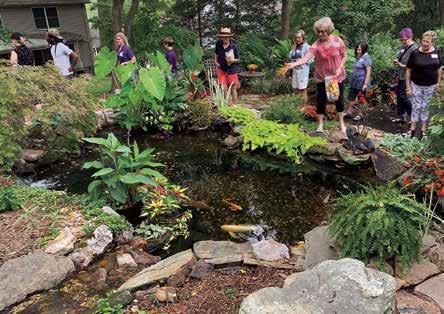
bench and enjoy the view! The purpose of SPLASH! is to raise money for a worthy charity. 100% of proceeds this year benefit Wildlife Rehabilitation Clinic. Tickets include breakfast at one of the beautiful gardens, lunch at another host garden, and dinner at the last water feature on the tour. The buses begin and end at Chalily. Tickets will be available in store at Chalily or online at chalily.com.
Remember, for other summer events, please check out our upcoming events calendar in this issue and online calendar at gatewaygardener.com/events, where we’ll add information about tours, plant sales, classes and other events that come to us after publishing this issue.
Free event. Rain or shine. For more info visit www.nmzna.net, www.gatewaykoiandpondclub.org or call 314-276-9461
Media Sponsor:


Prairie. FREE. Greenscape Gardens, 2832 Barrett Station Rd., Manchester, MO 63021. FREE. Pre-registration is required on the St. Louis County website at https://tinyurl.com/ yc3v3pfj or by calling 314-6154386.
Updates to this information are often posted on our online events calendar at www. GatewayGardener.com, so check there for the latest details. Give us the details of your upcoming gardening, lawn or landscaping event and we’ll add it to our website and include it in our next issue. Deadline for printing in the September issue is August 1st.
June 1st
9am—Children’s Garden Club. Chickens. FREE. Queeny Park – Nursery #1, 1675 S. Mason Rd. (Queeny Park East Entrance), St. Louis 63131. FREE. Pre-registration is required on the St. Louis County website at https://tinyurl.com/ yc3v3pfj or by calling 314-6154386.
Aug. 3rd
9am—Children’s Garden Club. Nutrition and Harvesting Crops. FREE. Queeny Park – Nursery #1, 1675 S. Mason Rd. (Queeny Park East Entrance), St. Louis 63131. FREE. Pre-registration is required on the St. Louis County website at https://tinyurl.com/ yc3v3pfj or by calling 314-6154386.
Sept. 7th
9am—Children’s Garden Club. Plant a Pocket of
May 31st-June 1st
4-8 Fri., 9am-1pm Sat.— Gardens in Bloom Tour. Featuring gardens in Belleville and Swansea, IL. For more information contact U. of I. Extension (618) 939-3434 or ruth1@illinois.edu.
June 1st-2nd
10am—Annual Town and Country Garden Tour The Garden Tour includes both a walking tour of gardens in downtown Historic Hermann and a driving tour to gardens in the hills around Hermann. The $15 ticket price includes visits to at least five private gardens; these gardens are both in town and in the country and include a traditional foursquare garden. Tickets will be sold online before the tour at Eventeny and at Topiaries (138 E. 4th) in downtown Hermann during the tour from 10-4 on Saturday and 10-3 on Sunday. Gardens close at 5PM on Saturday and 4PM on Sunday. A map to the gardens will be provided starting on Saturday June 3rd at the Topiaries ticket sale site. The Hermann Garden Club’s website www. hermanngardentours. com provides up-to-date events, ticket prices, links to the online ticket sale site, contact numbers, and photographs of past tour gardens. A special new event, The Garden Club Yard Sale, will begin at 10am on Friday at the
Rotunda in Upper City Park and continue until 6pm. There will be a preview from 3-6pm on Thursday; tickets for the preview are $10.
th1@illinois.edu.
June 5th
10am—The Language of Flowers Class. Passiglia Landscape, Nursery & Garden Center, 1855 MO-109, Wildwood, MO 63038. (636) 458-9202, passiglia@passiglia. com. Passiglia.com.
June 6th-7th
Noon-5pm Thurs., 9am-3pm Fri.—”Explore St. Louis”, a Small Standard Judged Flower Show. Hosted by The Garden Appreciation Club of Greater St. Louis and the Forsythia Garden Club. See specimens from garden club member’s gardens along with beautiful arrangements interpreting St. Louis’ famous landmarks and destinations.
Open to the public in Meeting Room 2 at the St. Louis County Library Thornhill Branch, 12863 Willowyck Dr, St. Louis, MO 63146.
June 13th
6pm—Evening Concert in the Garden. Passiglia Landscape, Nursery & Garden Center, 1855 MO-109, Wildwood, MO 63038. (636) 458-9202, passiglia@ passiglia.com. Passiglia.com.
June 15th
9am-5pm—St. Louis Carnivorous Plant Society 2024 Annual Show and Sale. Missouri Botanical Garden right off the main entry in the Farr Auditorium.
Open to the public unless sold out early. Proceeds go to organizations and preserves in the United States to help promote education and protect the habitat of carnivorous plants. We will have an educational
section with show plants and members available to answer questions. The Orchid Society, MASI, and Gesneriad Society will all have sale tables as well.
June 20th
6-7:30pm—Vermicomposting. Part of the Composting Class Series hosted by Seed St Louis, Table to Garden, and Willoughby Heritage Farm. Specific classes cover in-depth information and hands-on skills for compost bin systems, vermicomposting (worm composting), compost tumblers, Bokashi fermentation, and static compost systems. Wrap up the series with a microscopic examination of compost samples and free potluck dinner in October! All classes will be held at the new Compost Demonstration site at Willoughby Heritage Farm, 631 Willoughby Lane, Collinsville, IL 62234. Classes are $12/ea. Visit https://bit.ly/3GE34ws for more information and to register.
June 22nd
9am-3pm—Daffy Dill Garden Club Festival of Flowers and Statue Garden Walk. A day in the garden enjoying flowers, food and craft vendors. At the corner of North Broadway and Boone St. in Salem, IL.
June 22nd
9am-5pm—25th Annual Kimmswick Day Lily Sale. Sale to be held at the state inspected garden of Mr. Carrol Wrather, #6005 4th Street, Kimmswick, MO 63053. Offering over 1200 freshly dug & bagged plants, featuring over 100 different varieties. This is a great opportunity to purchase new and older varieties not available in nurseries or garden centers. The sale often sells out, so be sure to arrive early for best selection. Early Bird Specials are in short supply. Proceeds
benefit the Kimmswick Visitor Center. For information call (636) 464-6464.
June 22nd-23rd
9am-5pm—2024 Pond-ORama Tour. The 2024 tour will feature 24 private gardens owned and maintained by Society members. Tickets covering both days of the tour are $20 each (18 and older) and will be available at local retail shops and garden centers throughout the metropolitan area or on our website. A special 2024 Discount: Groups of 5 or more are only $15 each. The gardens are located throughout the St. Louis metropolitan area. This selfguided tour is arranged each day by geographic location. This year there are many new members who are excited to share their new ponds and waterfalls. The tour ticket booklet provides location addresses, descriptions and driving directions. For more information on where to purchase tickets by mail order from the Society’s website, www.slwgs.org, and at many of our retailers and garden centers.
June 23rd
noon-4pm—New Town Garden Tour. Tickets $10.00. Start at New Town Town Hall in St. Charles. Contact Terri at terristeffes1117@gmail.com for more information or to purchase tickets.
June 30th
11am-4pm— The Sustainable Backyard Tour. Explore ecofriendly spaces throughout the St. Louis region for FREE! Talk to organic gardeners, orchardists, vegetable growers, chickenkeepers, beekeepers and more! Pick up tips on stormwater management, renewable energy and water conservation among other vital topics. Register to attend, host, volunteer or sponsor at SustainableBackyard.org.
June 30th
1pm—Build Your Own
Meditation Garden. Passiglia
Landscape, Nursery & Garden Center, 1855 MO-109, Wildwood, MO 63038. (636) 458-9202, passiglia@passiglia. com. Passiglia.com.
July 10th
10am—Lavender Wreath Workshop. Passiglia Landscape, Nursery & Garden Center, 1855 MO-109, Wildwood, MO 63038. (636) 458-9202, passiglia@passiglia. com. Passiglia.com.
July 18th
6-7:30pm—Compost Tumblers
Part of the Composting Class Series hosted by Seed St Louis, Table to Garden, and Willoughby Heritage Farm. See listing under June 20th for details.
July 20th
10am—Garden Tablescapes. Passiglia Landscape, Nursery & Garden Center, 1855 MO-109, Wildwood, MO 63038. (636) 458-9202, passiglia@passiglia. com. Passiglia.com.
July 20th-21st
9am-5pm Sat., 9am-4pm
Sun.—Henry Shaw Cactus and Succulent Society Annual Cactus and Succulent Sale and Show. The HSCSS sale features multiple vendors for an incredible selection, from starter plants and popular succulents to rare specimen cacti. Great pots, too. And don’t miss the special display of succulents from around the world. FREE admission. I-70 Business Center, 8195 Lackland, 63114. Visit hscactus.org/ for more information.
July 28th
1pm—Build Your Own Native Grasses and FLowers. Passiglia Landscape, Nursery & Garden Center, 1855 MO-109, Wildwood, MO 63038. (636) 458-9202, passiglia@passiglia. com. Passiglia.com.
August 7th
10am—How to Illuminate your Landscape. Passiglia
Landscape, Nursery & Garden Center, 1855 MO-109, Wildwood, MO 63038. (636) 458-9202, passiglia@passiglia. com. Passiglia.com.
August 9th
Noon-4pm—Standard Flower Show. Boone Country Garden Club is hosting an National Garden Club (NGC) Standard Flower Show at the Weldon Springs Interpretive Center in St. Charles, MO 63303. This show is FREE and open to the public. Our 40 local club members will be participating in this show placing their personally grown plant specimens in the Horticulture Division, flower and petite floral designs in the Design Division, and up to date information on best practices in gardening in the Educational Division.
August 15th
6-7:30pm—Bokashi Part of the Composting Class Series hosted by Seed St Louis, Table to Garden, and Willoughby Heritage Farm. See listing under June 20th for details.
August 17th
Herbal Teas and Local Honey. Passiglia Landscape, Nursery & Garden Center, 1855 MO-109, Wildwood, MO 63038. (636) 458-9202, passiglia@passiglia. com. Passiglia.com.
August 24th
8am-noon—15th Annual Home Grown Farm Tour Farm & Charm, Farm Festival Party & Benefit Concert, Plus Field Dinner. See details on page 20.
August 25th
1pm—Fall Porch Pot Workshop. Passiglia Landscape, Nursery & Garden Center, 1855 MO-109, Wildwood, MO 63038. (636) 458-9202, passiglia@ passiglia.com. Passiglia.com.

